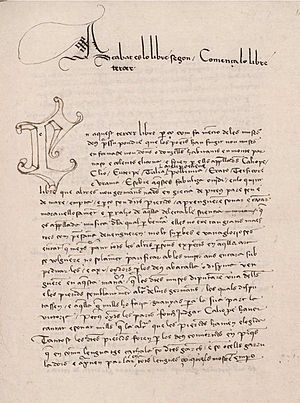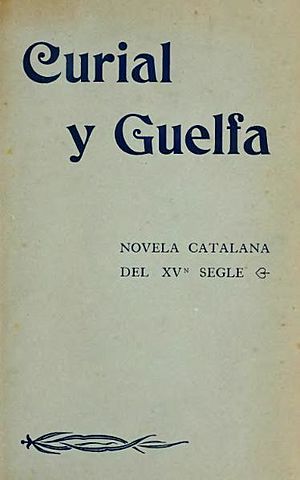Curial e Güelfa facts for kids
Curial e Güelfa is an old story from the 1400s, written in the Catalan language. It's a chivalric romance, which means it's about knights, adventures, and love. What makes it special is that it also includes ideas from Italian humanism, a way of thinking that focused on human values and achievements.
This story is known from only one copy, a single handwritten book. It wasn't published until the 1900s. Today, people see it as a very original and important work.
The story takes place in the late 1200s. The main characters are Curial, a knight, and Güelfa, a noble lady. Curial travels a lot, doing brave deeds. But he and Güelfa have a disagreement. Later, Curial's ship sinks, and he becomes a slave in a faraway land. He eventually escapes with a lot of money. After winning battles against the people who enslaved him, he finally reunites with Güelfa.
Contents
When and Where Was It Written?
Curial e Güelfa was probably written around 1443 to 1448. It mentions a group of knights called the Hospitallers in Spain. This suggests it was finished before 1462, when that group split into two parts.
The story is written in the Valencian dialect of Catalan. This was a popular and important dialect at the time. This was because King Alfonso the Magnanimous of Aragon lived in Valencia before 1432. The author also seemed to know Italian and Castilian. Most experts believe the book was written in Italy.
Many people have tried to guess who wrote this story. Some think it was Joan Olzina, who worked for King Alfonso. Others suggest Lluís Sescases, the king's librarian. More recently, some have pointed to Íñigo Dávalos, a Castilian who served King Alfonso. However, there's no clear agreement on who the author was.
Some people thought the story might be a translation from Italian. While this isn't widely accepted, it's true that the story feels very Italian in its style. There was also a strange idea that Curial might be a fake from the 1800s. But today, almost everyone agrees it's a real story from the 1400s. The old paper, ink, and binding of the manuscript prove it's from that time.
The Story's Journey Through Time
We only know of one single handwritten copy, or manuscript, of Curial e Güelfa. This copy is now kept in the Spanish National Library in Madrid. For a long time, it was forgotten. Then, in 1876, Manuel Milà i Fontanals rediscovered it. The first time the story was printed as a book was in 1901.
The manuscript doesn't have a date, title, or dedication at the beginning. This is because the very first part of the book is missing. The story itself is complete, though. There are a few blank spaces in the copy, which suggests it was copied from an unfinished draft. It's not the original handwritten version by the author.
The manuscript has 224 folios, which means 448 pages. The paper has special marks called watermarks. The book's cover is in a style called Mudéjar, with iron clasps, which was common in Castile. The handwriting looks like the Catalan style used by scribes who copied official documents. The manuscript was probably made by a scribe who spoke Aragonese or Castilian.
Curial e Güelfa has been translated into English twice. It has also been translated into Spanish, French, Portuguese, Italian, and German.
What Is Curial e Güelfa About?
The title Curial e Güelfa is not the original one. It was made up by Antoni Rubió i Lluch, who edited the first printed version in 1901. The title simply uses the names of the two main characters. Curial is a poor knight who serves the marquis of Montferrat. Güelfa is the marquis's sister and the widow of the duke of Milan.
The story takes place in many different countries. These include Italy, Germany, Hungary, France, England, Greece, the Holy Land, Egypt, and Tunisia. It mentions Catalonia, but not Valencia. The story is set during the time of King Peter III of Aragon (1276–1285). While the love story feels Italian, the knightly adventures are very French in style. Most of the brave deeds happen in France.
Curial is divided into three main parts, called books. Each book has an introduction and is split into chapters. The chapters don't have titles. In the manuscript, there were spaces left for fancy letters at the start of each chapter, but these were never added.
A famous expert, Martí de Riquer, said that Curial is "a strikingly original work, written with skill, an excellent style, and a good narrative sense."
Book One
In the first book, Curial convinces Güelfa to become his protector. She asks her main servant, Melchior de Pandó, to teach him. But two jealous people at court spread rumors about Curial and Güelfa. Because of this, the marquis banishes Curial from the court.
Curial travels to Austria. There, he defeats the knights who spread the false rumors. The duchess's father, the duke of Bavaria, offers Curial the hand of his other daughter, the beautiful Laquesis, in marriage. Even though Curial falls in love with her, he says no. When Güelfa hears about this marriage offer, she becomes very jealous. Curial returns to Montferrat. There, with the help of three Catalan knights, he wins a tournament held by the marquis. He defeats a knight named Boca de Far.
Book Two
In the second book, Curial goes to a tournament held by the king of France in Melun. Güelfa's maid, Arta, goes with him, pretending to be someone else. On the way, Curial performs many acts of knight errantry, helping people in need. He also joins four knights from Aragon.
At Melun, Curial fights for Güelfa's honor. He takes the side of the Aragonese and Burgundian knights against the French and Bretons. King Peter of Aragon also fights in the tournament, but no one knows who he is. Curial defeats every opponent, and Laquesis is there to see it. Afterward, Güelfa tells him to stay in Paris. There, he defeats a knight known as the "Boar of Vilahir."
Curial eventually returns to Montferrat to clear his name from more false accusations. But Güelfa refuses to protect him again. She only changes her mind after the French court, meeting at Le Puy, speaks up for him.
Book Three
In the third book, Curial travels through the Holy Land and Greece. At Saint Catherine's Monastery in Sinai, he meets the Boar of Vilahir again. The Boar has changed his ways and is now a Franciscan monk.
In a dream, Curial visits Mount Parnassus. There, the Muses (goddesses of art and knowledge) ask him a question: "Was Achilles' defeat of Hector in the Trojan War fair according to the rules of chivalry?" On his way back home, his ship sinks in Tunisia. He is forced to work as a slave for seven years for a man named Fàraig. Fàraig's daughter, Càmar, falls in love with Curial. With help from the Aragonese ambassador, Curial is set free.
Curial returns to Montferrat in disguise. But Güelfa recognizes him when he sings a special song. Still, she won't take him back. He goes to the French court, where he receives many rewards. He then raises an army to fight the Turks and rescues Güelfa's brother in battle. The marquis is pleased with Curial again. The emperor of Constantinople also rewards him.
Finally, Curial attends another tournament before the French court at Le Puy. The court speaks up for him again, and Güelfa finally takes him back. Curial and Güelfa get married.
What Inspired the Story?
The main plot of Curial comes from an old Italian story, novella 61, found in a collection called Cento novelle antiche from the 1200s.
Curial is quite realistic, similar to French knightly stories of the time. The basic plot is also like another story called Le Petit Jehan de Saintré. However, most of the ideas and influences in Curial come from Italy. The author was greatly inspired by early Italian humanists like Dante, Petrarch, and Boccaccio. For example, Boccaccio's Filocolo and a commentary on Dante's Divine Comedy were used as models. The story also uses ideas from the Matter of Britain, which are legends about King Arthur and his knights.
The author of Curial knew the story of Paris e Viana. A copy of this story was in the royal library in Valencia in 1417.
The "elephant song" that Curial sings for Güelfa is actually a real song. It was composed by a poet named Rigaut de Berbezilh.
The character Càmar, who falls in love with Curial, is similar to Dido from Virgil's famous Roman poem, Aeneid. The book also mentions Mythologiae by Fulgentius. The name Laquesis comes from Lachesis in Plato's Republic.
The way King Peter is described in Curial matches how he is shown in the historical writings of Bernat Desclot. The names of two characters might be based on real people from the 1400s in Naples. Melcior de Pando might be based on the Pandone counts of Venafro, and Boca de Far on the knight Bucca di Faro. Some experts believe that the author learned about these historical figures through Italian history books, not directly from the original Catalan writings.
See also
 In Spanish: Curial e Güelfa para niños
In Spanish: Curial e Güelfa para niños




